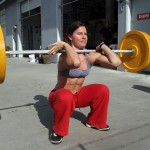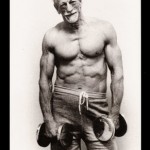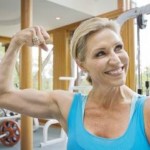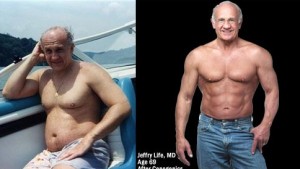How to Keep Your Metabolism Fired-Up as You Age (How to slow the slowing…):
Welcome back to the next to last on this series aboiut your metabolism.
Your Resting Metabolic Rate or RMR is where the majority of our calorie / kilojoule use takes place. The higher this is, the less fat we carry. You see, as we’ve discussed before decreases in your RMR are heavily associated with the reduction of lean muscle tissue.
Age-related weight gain is purely a function of the loss of muscle.
 Muscle is a hungry tissue and requires a lot of calories to maintain. The more functional muscle mass you have the faster your metabolism and the lower your fat stores. Muscle tissue atrophies –diminishes – as we age because in general we move less, exercise less and become generally physically less active.
Muscle is a hungry tissue and requires a lot of calories to maintain. The more functional muscle mass you have the faster your metabolism and the lower your fat stores. Muscle tissue atrophies –diminishes – as we age because in general we move less, exercise less and become generally physically less active.
While it’s not entirely clear whether this muscle loss is just a result of the ageing process or because most people become less and less active as they get older, what is clear that you do not have to accept it as inevitable.
It is hard to argue with your mitochondria, but nonetheless you can offset many of the factors which cause the slowing of your metabolism. The quickest way to disrupt your current metabolic set point and loosen your current homeostatic state is through metabolically costly exercise. Challenging regular exercise actually increases the number of mitochondria and as we’ve seen already, the more of these little ‘furnaces’ you have, the more calories you burn. (See the soon to be released Lose 20 in 30 Work Out Manual)
Research has shown that regular, metabolically taxing strength and resistance training can reduce, reverse or even prevent this muscle loss. This in turn leads to less fat. So the first way we can work to negate the
metabolic slowing effects of aging is by maintaining our muscle mass through regular challenging conscious exercise.
Move more and lift weights dammit!
However the type, duration and choice of exercises are vitally important. A specific exercise protocol called Metabolic Conditioning (referred to as Metabolic Chains in the promised Lose 20 in 30 program) has to be used. The up coming Lose 20 in 30 Exercise Manual has all of the details on this.
But exercise is only one of a number of the lifestyle modifications that you can adopt to keep your metabolic rate fired-up – regardless of your age.
What can I do to increase or maintain my metabolic rate as I age?
You can (Warning – recap of some previous information ahead!!):
- Ensure that you engage in at least 20 to 25 minutes of medium to high metabolic cost exercise every second day
- Ensure that you engage in 20 – 35 minutes of moderate physical activity on the alternate days.
- Begin eating more small meals throughout the days instead of just 1 or 2 larger meals.
- Look for other small ways to move more and stay more active. Take a parking spot away from the main entrance of the mall. Likewise do the now clichéd but still effective, take the steps instead of the elevator. Give the dog an extra walk each day or just go for a walk each evening after dinner etc etc.
- Stop drinking soda & fruit juices and drink more cold water and green tea instead.
- Avoid foods that contain high levels of saturated fats and any level of transfats wherever possible.
-
Avoid highly processed foods wherever possible especially the ‘whites’ – sugar, flour, rice and other processed carbs.
- Don’t eat anything labelled ‘diet’
- Try to eat more un – or low processed foods like fruit & veges, fish, eggs and protein.
- Eat more protein & fibre.
- Add spices to your meals.
- Take fish oil
- Take Vitamn D ( the D3 version NOT the D2)
- Eat like the Lose 20 in 30 Fuel manual suggests – slow, low GI carbs, good fats, lean proteins and as little processed carbs as possible.
- Try out stress reducing activities like Yoga, Pilates, Tai Chi or start meditating daily. A walk on the beach, in the Park, in a Forest or a Field – are all great stress busters.
- Take 500mg of Vitamin C when stressed this will reduce cortisol significantly.
- Make love more often.
Your metabolic rate has always been, and will always be, a result of a combination of your activity levels, caloric intake, and the types of foods that you consume. Low or unprocessed foods are simply better for your metabolism and make it easier for your body to maintain a faster metabolism.
It’s very important for all of us, regardless of our ages, to eat better proper foods, more often and to maintain regular levels of physical activity. To a very large degree your metabolic rate is yours to control.
Remember your age or even your sex does not matter, in order to lose fat fast, efficiently and to transform your metabolism three things have to fall into place – you must have an absolute burning desire to change the way you look & feel, you must have a strategic training protocol to follow which disrupts your current
homeostatic set point and ramps up & re-conditions your metabolism and lastly you must follow a diet that supports the reconditioning of your metabolism by creating a calorie deficit whilst firing up your metabolism and manipulating your hormones.
In the end, age will slow us down. But by staying active and eating well, the experts agree: You can slow the effects of a slowing metabolism.To a very large extent your metabolic rate is yours to control.
Take Away: You’ve heard it before – you don’t have to accept the metabolic slow down of aging – you can offset it!!










